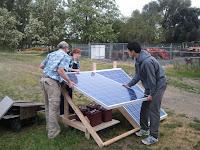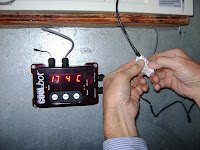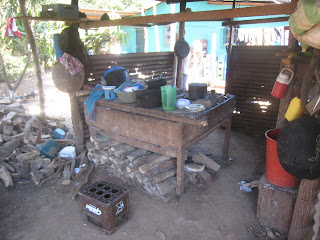Financially, the cost of the system would decrease dramatically if the demand for electricity can be decreased. Thanks to the HOMER model of this particular building and photovoltaic system as developed by D-Lab I, the R-value of the insulation used relates directly to the electric load of the system. A high R-value, or more effective the insulation, will require the air conditioning unit (which cools the room) to run less frequently, using less electricity.
The five-farmer group in Yabiavoko village, Arua District in Uganda are planning to insulate the building with dry grass, stuffed into polystyrene bags. In order to determine the effectiveness of this and other insulation materials available locally in Uganda, the DLab CoolBot Group, in collaboration with Reach Your Destiny Consult, focused on building a device capable of determining the R-value of various insulation materials in the field. As requested, they also researched possible roof designs for a round structure that is fire retardant, minimizes cost and provides adequate insulation.
Here is a two minute video summary about the project.
Insulation-testing Device Design Considerations:
The goal was to determine the R-value of various insulation materials under local conditions. Bay measuring the time it takes the inside of a box to reach a constant temperature, given that it is split by an insulation material (can vary) and one side of the box can be heated to a known temperature.
What was learned from the prototypes:
Second Prototype
![]() The D-Lab team measured effectiveness over time (rate at which temperature stabilizes) with a picologger temperature sensor, using two different box designs (see pictures). The “hot box” uses sodium acetate packets as a phase-change material to create a temperature difference between two compartments, divided by the insulation material to be tested. The “glass tube” is heated by a thermocouple wire, connected to a power source in the lab (possibly a battery in the field). Temperature sensors on both sides of the insulation material quantified heat transfer.
The D-Lab team measured effectiveness over time (rate at which temperature stabilizes) with a picologger temperature sensor, using two different box designs (see pictures). The “hot box” uses sodium acetate packets as a phase-change material to create a temperature difference between two compartments, divided by the insulation material to be tested. The “glass tube” is heated by a thermocouple wire, connected to a power source in the lab (possibly a battery in the field). Temperature sensors on both sides of the insulation material quantified heat transfer.
Criteria and Metrics: Demonstration Coolroom
Recommendation 1:
◦ Square ceiling on top of the existing round structure.
◦ 2-3 ft knee wall on one side to catch rafters.
◦ Ample room for insulation between ceiling joists and rafters.
Recommendation 2:
◦ Build a circular ceiling
◦ Progressively narrow the brick wall, igloo-style to seal off the roof.
◦ Ample room for insulation between ceiling and igloo-style brick roof.
Insulation-testing Device Design Considerations:
- Portability: Test must fit inside a carry-on bag, with dimensions less than 22”x16”x8”, and weigh less than 26lbs. Does not require grid electricity, and provides results in under one hour.
- Effective Comparative Test: The calibrated model must provide results within 10% of literature value.
- Accurate in Variable Weather: Effective test when carried out in high humidity, direct sunlight, and wind.
- Affordable: Total cost of device must be less than $50.00
The goal was to determine the R-value of various insulation materials under local conditions. Bay measuring the time it takes the inside of a box to reach a constant temperature, given that it is split by an insulation material (can vary) and one side of the box can be heated to a known temperature.
What was learned from the prototypes:
Second Prototype
Project Results:
- Hot Box Prototype: the sodium acetate hot/cold packs are a reliable source of temperature, but dimensions of box must take air currents and the insulation of air into consideration
- Glass Tube Prototype: determined validity of procedure and appropriate thermocouple wire resistance/voltage necessary for heat generation.
- Next Steps: build working models of prototypes, meeting design criteria. Bring to Uganda for use by Arua district farmers, and collect feedback from end-users for further improvement.
Roof Design
Affordable: Total cost less than $250.00
- Fits local needs: Round roof design that prevents water from entering structure during heavy rain.
Recommendation 1:
◦ Square ceiling on top of the existing round structure.
◦ 2-3 ft knee wall on one side to catch rafters.
◦ Ample room for insulation between ceiling joists and rafters.
Recommendation 2:
◦ Build a circular ceiling
◦ Progressively narrow the brick wall, igloo-style to seal off the roof.
◦ Ample room for insulation between ceiling and igloo-style brick roof.




































